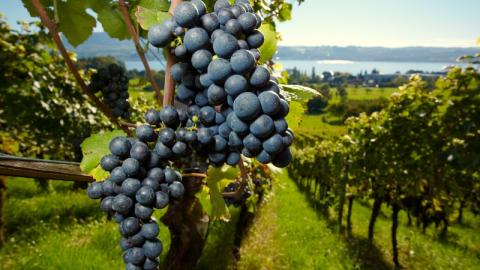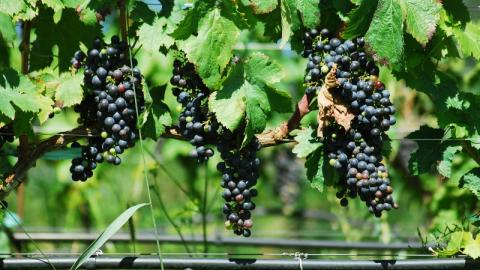The wine-growers’ trade associations of the Côtes de Provence and Coteaux Varois regions and the producers of the PGI wines of the Var region, the Company Canal de Provence and the Chamber of Agriculture are working together to irrigate the vineyards of the Var region and offset the adverse effects of climate change.

A weakening of the vine stock, aroma loss and deterioration, a reduction in the acidity of the wines, excessive tannins and loss of yield, with serious repercussions for several years’ harvests, even leading to the phenomenon of a dieback in the vineyards of the south of France, are just some of the consequences of the increased level of water stress over the last few years.
In the face of the recent higher temperatures, the frequency and intensity of the droughts, the vineyards have come up with a number of possible adaptation options: replacing the more sensitive vine varieties with more resistant ones, improving the physical properties of the soil or using
well-managed irrigation techniques. Without adaptation, the quality of the controlled designation of origin (AOC) wines will suffer. The challenge facing the industry today is the sustainability of the vineyard, which has an economic impact on the whole of the wine industry.
Irrigation is the main mechanism used in the alleviation of plant water stress. In particular, as far as tolerating a lack of water is concerned, Rosé Wine production (90% of the volumes produced in the AOC Côtes de Provence region) is more sensitive than the production of tannic, coloured or aged red wines. Irrigation allows the vine’s metabolism to be fine-tuned during the dry years and thus maintain an even quality from one next to the other and also meet the performance targets of the quality label, in this way ensuring that there is a regular volume of production for the market.
In view of this fact, the Company Canal de Provence, in partnership with the wine-growers’ associations and Chamber of Agriculture, is planning to develop its irrigation networks throughout the area concerned, i.e. about 20,000 ha over the whole Var region.
This partnership will be formalised on 18th December 2017, at the wine house of Côtes de Provence, in an agreement that sets out the common objectives and role to be played by each of the players involved.
Genesis of an ambitious project
The irrigation of the grapevine is one of the major challenges facing wine-growers’ associations and the SCP over the coming years.
Faced with the predictable effects of climate change, resulting in a rise in temperature and higher evapotranspiration for the crops and more dry periods, efficiently-managed irrigation of the vines is a means of adaptation that would guarantee the sustainability of wine-growing in the region, and more specifically in the department of the VAR (Côtes de Provence, Coteaux Varois in Provence and the PGI wine producers of the Var region). Irrigation thus ensures the quality and quantity of the production and helps to preserve the export markets.
A partnership agreement was, therefore, signed on 18th December 2017
The object has been to install new water resource infrastructures in the Var region in order to serve and support the local wine-growing areas, which represent a total surface area of around 20,000 ha. An initial agreement will be signed, defining the following objectives:
• Increase access to water for the wine-growers of the Var region and thus extend the irrigation networks available for the vines, for a higher proportion of vineyards within reach of the main production regions.
• Facilitate the rapid implementation of these irrigation networks so that they operate as close as possible to the producers and also supply the whole area covered by these 3 denominations of origin,
• Convince the local authorities and institutional bodies of the benefits of irrigation for the wine-growing sector and the need for its development,
• Through a communications strategy, help the general public and opinion-formers accept the irrigation of vineyards,
• Define the ways in which the wine-growers can contribute towards the financing of the water resource facilities, in conjunction with the local authorities and public bodies, as well as self-financing by the Company Canal de Provence itself, in order to create the conditions of financial stability required for the projects to take place.
• Raise funds from the sector’s main players and the local authorities and public bodies.
The implications of this water stress : A moderate water deficit is beneficial for the vine
A moderate level of water deficit is required to maintain the normal vigour of the vine and obtain a balance between optimum and non-excessive vegetative growth and good sugar accumulation in the berries (Carbonneau, 1999)
Severe water stress, i.e. the appearance of water deficit symptoms, is noticeable when the vine initiates mechanisms aimed at limiting water loss.
“Irrigation, previously considered as a production component, should now be classified as a crucial factor for sustainability”.
The general population tends to consider that there is a strong link between a grape vine that suffers from a water deficit and a good vintage. In the words of Mr. Alain Carbonneau, from Agrosup Montpelier, the grape vine should not be subjected to excessive water stress.
However, over recent years, the level of water deficit has been such that we have gone past the stage where water stress is beneficial to the point where the plant is really suffering from a severe lack of water.
As shown in the table above, the cumulative rainfall figures for the early part of 2017 as recorded at the different weather stations in the Val region, are lower than the ten-yearly average for the same time period.
What are the consequences for the grape vine?
Water stress has an impact on vegetative growth, cluster development and photosynthesis. It leads to a loss of yield, which could also have repercussions for several years’ harvests, a decline in the oenological potential of the grapes (sugar is no longer transported to the berries, a deterioration in the aromas, loss of acidity, increased astringency and reduced colour stability) and a general weakening of the vine stock.
This is not the desired effect intended for the Côtes de Provence wine-growing region, which primarily produces Rosé wines. The wines produced within this context are unsuitable for the desired product profile: Rosé wines that are light-coloured, dry, around 12.5% alcohol, with a slight astringency, moderate acidity and aromatic freshness.



